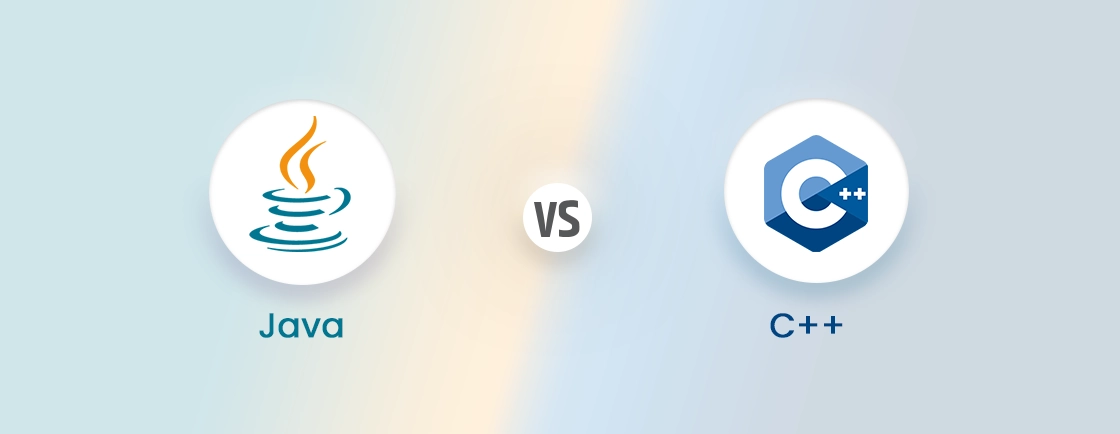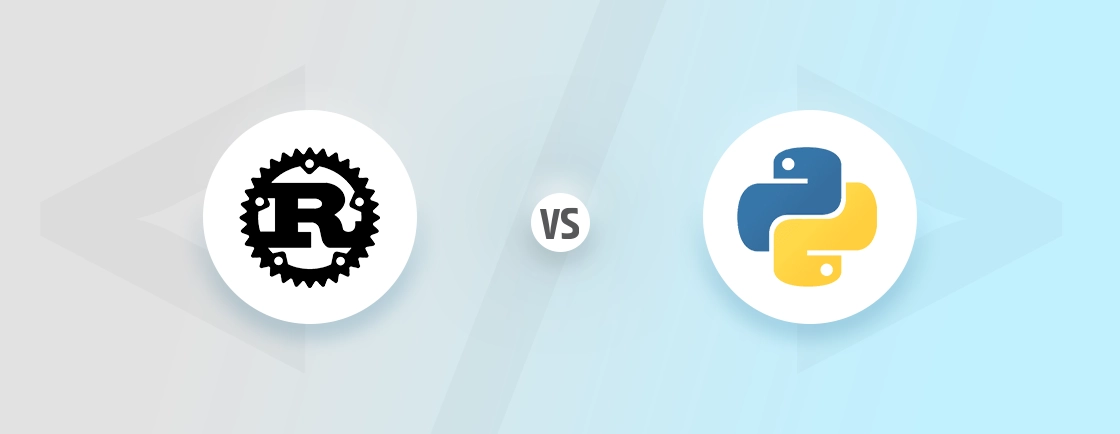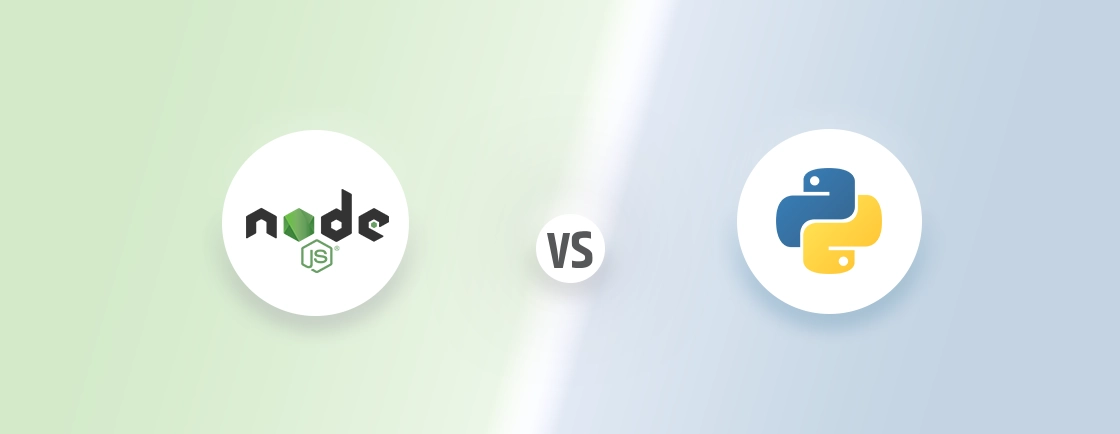Quick Summary
The choice between CakePHP and Laravel boils down to convention versus flexibility. CakePHP’s “convention over configuration” philosophy means you can build standard applications faster with less decision-making. Laravel, on the other hand, offers elegant syntax, a powerful ORM (Eloquent), and a vast array of tools for complex, scalable applications. For most projects, Laravel is the prevailing choice. However, CakePHP can be good where long-term stability and a gentle learning curve are top priorities.
Table of Contents
You’re ready to build a new PHP-powered web application, but there’s a critical debate on the mound: which PHP framework will be suitable for you? CakePHP or Laravel? The right choice dictates not just the initial build, but also long-term maintenance, scalability, and efficiency.
While both are powerful tools, their core philosophies differ significantly. This analysis cuts through the hype to compare CakePHP vs Laravel based on their conventions, performance, and more. Let’s begin.
CakePHP vs Laravel: Comparison Table
| Factor | CakePHP | Laravel |
|---|---|---|
| Architecture | HMVC (Hierarchical Model-View-Controller) | MVC (Model-View-Controller) |
| Learning Curve | Easier, convention-based | Steeper, industry-standard |
| Development Speed | Faster, auto-scaffolding | Balanced, flexible routing |
| Community Size | Smaller but active | Larger, extensive resources |
| Security Features | Built-in input validation, CSRF protection, SQL injection prevention | Similar features, additional security packages available |
| Database Interaction | ORM (Object-Relational Mapping) | Eloquent ORM |
| Routing | Convention-based, flexible | Expressive syntax, route parameters, middleware |
| Templating Engine | Twig | Blade (lightweight, templating inheritance) |
| Authentication & Authorization | Built-in authentication, authorization via ACL | Built-in, roles, abilities, gates, policies |
| Testing Framework | Unit and integration testing support | Built-in PHPUnit integration |
| Community Package | Smaller selection | Vast library of community-developed packages |
| Ideal for | Smaller projects, rapid development, content-driven applications | Complex, feature-rich applications, large-scale projects |
Overview of CakePHP
CakePHP is a robust, convention-over-configuration framework designed for rapid and structured development. Its “batteries-included” philosophy provides a complete toolkit out-of-the-box, enforcing consistent coding standards.
That makes it exceptionally well-suited for building business applications, such as internal CRMs or data-driven platforms. There, maintainability and a predictable architecture are often more critical than bleeding-edge flexibility. It prioritizes simplicity and a streamlined workflow.
Key Features of CakePHP
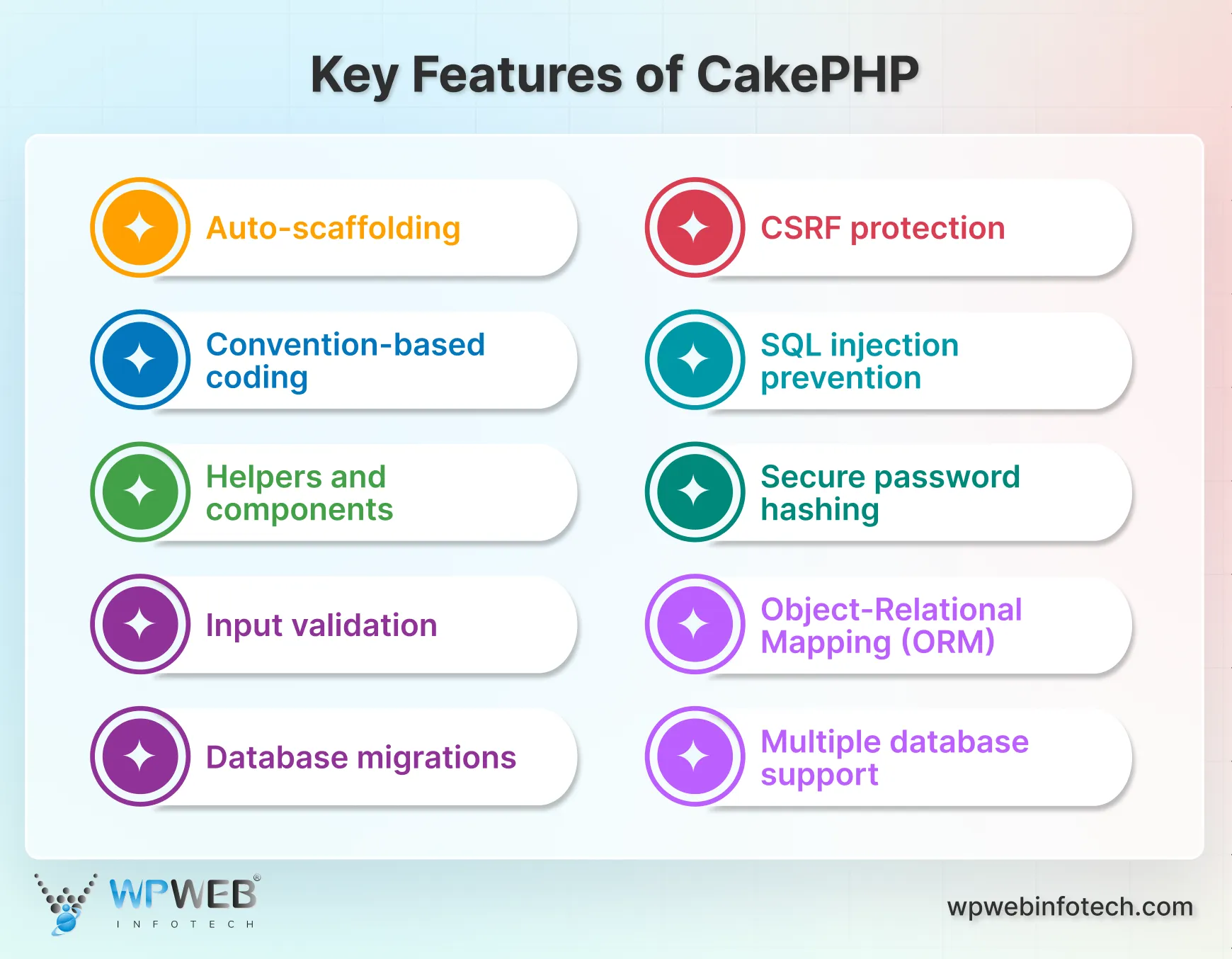
- Auto-scaffolding: Generate basic CRUD (Create, Read, Update, Delete) functionality with minimal code. That saves you precious development time.
- Convention-based coding: Follow clear naming rules for files, classes, and actions. This keeps your code organized and easier to understand for you and your team.
- Helpers and components: Reusable modules for common tasks like form handling, data validation, and security checks. That helps keep your code clean and organized.
- Input validation: Protect your application from malicious code injection by validating user input before processing it.
- CSRF protection: Prevents unauthorized actions caused by Cross-Site Request Forgery attacks.
- SQL injection prevention: Safeguard your database from SQL injection vulnerabilities by escaping user input before using it in queries.
- Secure password hashing: Stores passwords securely using industry-standard hashing algorithms.
- Object-Relational Mapping (ORM): Simplifies database interactions by mapping objects to database tables. It helps simplify complex queries and data manipulation.
- Database migrations: Manage database schema changes in a controlled and versioned way.
- Multiple database support: Connect to various database types like MySQL, PostgreSQL, and SQLite.
Pros & Cons of CakePHP
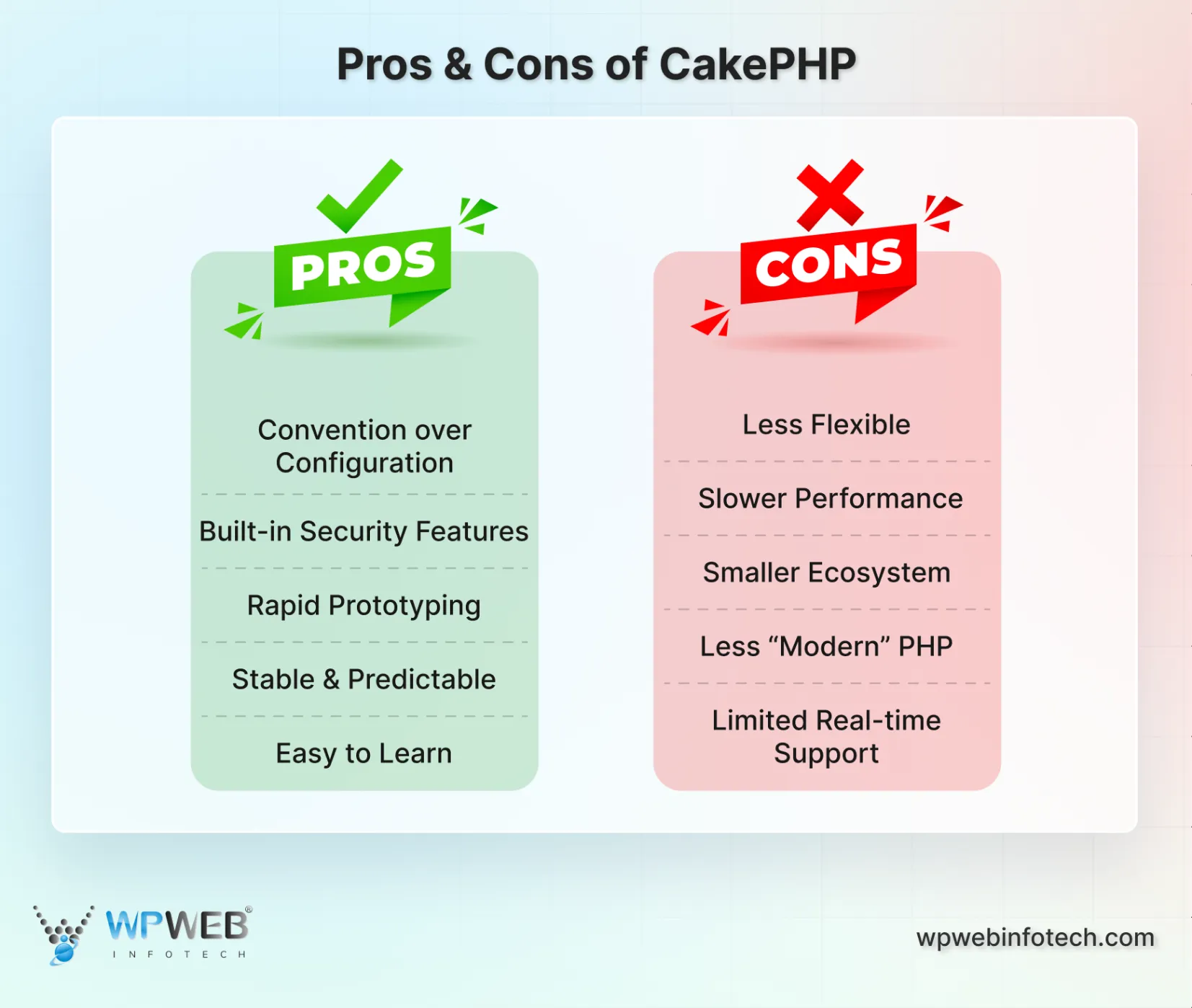
Pros of CakePHP
- Convention over Configuration: CakePHP helps heavily reduce the development time by minimizing setup decisions; things “just work”.
- Built-in Security Features: You get built-in tools for input validation, CSRF protection, and SQL injection prevention out-of-the-box.
- Rapid Prototyping: Features like scaffolding and code generation tools (Bake) ensure quick creation of basic CRUD applications.
- Stable & Predictable: Known for its stability and backward compatibility, ideal for long-term, enterprise-level projects.
- Easy to Learn: Simpler structure and explicit conventions make it easier for beginners or those coming from a CodeIgniter background.
Cons of CakePHP
- Less Flexible: Strict conventions can feel restrictive when building highly customized or non-standard applications.
- Slower Performance: Generally considered slower out-of-the-box compared to modern frameworks like Laravel.
- Smaller Ecosystem: Has a smaller community and fewer packages/libraries compared to Laravel.
- Less “Modern” PHP: Traditionally slower to adopt the latest PHP features and programming trends (though this has improved).
- Limited Real-time Support: Not natively designed for real-time applications like WebSockets; requires extra work.
CakePHP offers a combination of user-friendliness, security, and powerful features. But where does it stand against Laravel? Before we discuss the comparison, let’s see a brief overview of Laravel.
Overview of Laravel
Launched in 2011, Laravel is an open-source PHP framework. It’s designed for building web applications with expressive syntax and intuitive features. Similar to CakePHP, Laravel follows the Model-View-Controller (MVC) architectural pattern. It separates the application’s logic, presentation, and data layers. So the code is clean and maintainable.
Laravel follows a “Convention over Configuration” philosophy. It encourages the developers to follow naming conventions and reduce the need for explicit configuration and boilerplate code. The Laravel experts focus on building unique features rather than repetitive tasks.
Key Features of Laravel
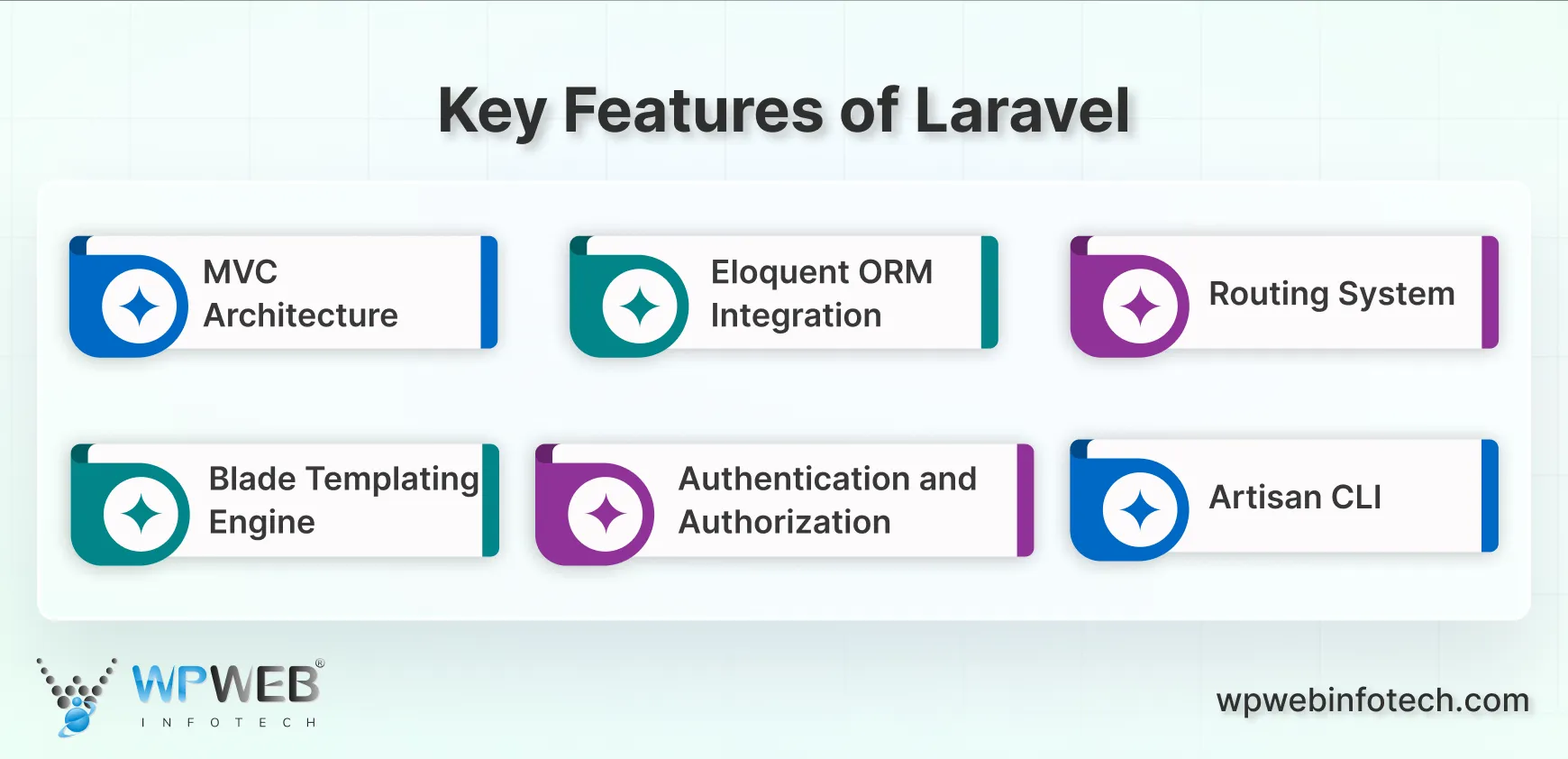
- MVC Architecture: Models handle data, Views present information, and Controllers manage application logic. It promotes code organization and maintainability.
- Eloquent ORM: Built-in Object-Relational Mapper (ORM) provides a powerful and intuitive way to interact with databases using PHP objects. Laravel Eloquent techniques simplify complex database queries and reduce boilerplate code.
- Routing System: Laravel routing techniques define routes for incoming HTTP requests using expressive syntax. It maps the URLs to specific controller actions.
- Blade Templating Engine: This powerful and lightweight templating engine focuses on readability and maintainability. It offers features like conditional logic, loops, and templating inheritance for dynamic views.
- Authentication and Authorization: Laravel Authentication takes care of user login, registration, and session management. And Authorization uses Laravel Policies and Gates for a granular control over resource access.
- Artisan CLI: Laravel offers a built-in command-line tool for generating code, managing migrations, and performing various development tasks. It automates repetitive tasks and improves development efficiency.
Pros & Cons of Laravel
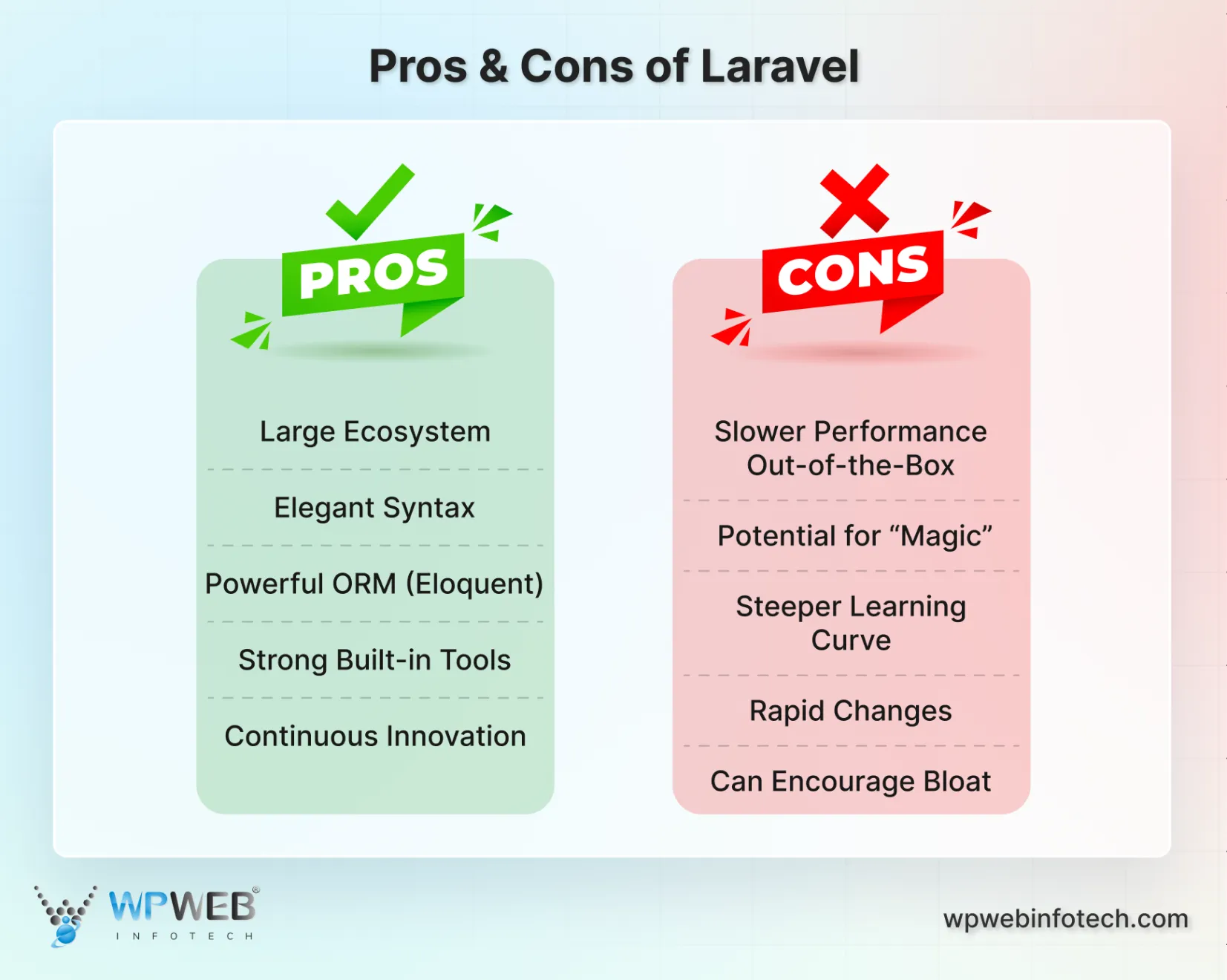
Pros of Laravel
- Large Ecosystem: Huge community, extensive packages (via Packalyst), and official products like Forge, Vapor, and Echo.
- Elegant Syntax: Expressive, readable syntax that is often described as “developer-friendly” and enjoyable to use.
- Powerful ORM (Eloquent): One of the best ORMs available, providing an intuitive and powerful way to interact with databases.
- Strong Built-in Tools: Includes robust features for queues, job scheduling, real-time events, and caching with minimal setup.
- Continuous Innovation: Frequent updates and early adoption of modern PHP features keep the framework on the cutting edge.
Cons of Laravel
- Slower Performance Out-of-the-Box: Can be resource-heavy compared to micro-frameworks, requiring optimization (caching) for high traffic.
- Potential for “Magic”: Heavy abstraction can sometimes make it difficult to understand what is happening under the hood when debugging.
- Steeper Learning Curve: The sheer number of features and abstractions (Facades, Service Container) can be overwhelming for beginners.
- Rapid Changes: Frequent major releases can require more effort to keep applications up-to-date.
- Can Encourage Bloat: Ease of adding features can lead to unnecessarily large applications if architecture is not carefully planned.
Laravel is an excellent PHP framework for creating dynamic, feature-rich websites and web apps. That’s why it is one of the preferred frameworks of web experts.
So, want help with building the best web applications using Laravel? Then our Laravel development services will be suitable.
For now, let’s move on to a comprehensive comparison between Laravel and CakePHP.
Comprehensive Difference Between CakePHP and Laravel
CakePHP and Laravel are both excellent platforms, and if you can’t decide from the table, here is a comprehensive differentiation between the two.
Architecture
CakePHP follows the Model-View-Controller (MVC) architectural pattern, which is a widely adopted approach for building web applications. In CakePHP’s MVC architecture:
- Model: Represents the data layer of the application. It encapsulates data access logic and interacts with the database. CakePHP’s ORM (Object-Relational Mapping) makes it easy to define and work with models, abstracting database tables as PHP objects.
- View: Represents the presentation layer of the application. It handles the rendering of data to the user interface. CakePHP uses template files (views) to generate HTML output. It allows developers to separate the presentation logic from other components.
- Controller: Acts as an intermediary between the model and the view. It processes user requests, interacts with the model to retrieve data, and passes data to the view for rendering.
CakePHP’s architecture promotes code organization and separation of concerns, making it easier to maintain and extend applications as they grow in complexity.
On the flip side, Laravel also follows the MVC pattern. But it also introduces additional architectural features like:
- Service Providers: Laravel uses service providers to bind dependencies, register components, and perform bootstrapping tasks. Service providers contribute to the framework’s extensibility and allow developers to encapsulate reusable functionality.
- Facades: Facades in Laravel provide a convenient way to access services and components from the IoC (Inversion of Control) container. They offer a static interface to underlying classes, simplifying code syntax and improving readability.
- Middleware: Laravel developers use Middleware to filter HTTP requests entering the application. Middleware can perform tasks such as authentication, logging, and request modification. So they can apply cross-cutting concerns to HTTP requests.
- Routing: Laravel’s routing system provides a flexible and expressive way to define application routes. Developers can define routes using a fluent API, specify route parameters, and group routes with common attributes.
These additional features help enhance the flexibility, extensibility, and developer productivity.
Verdict
Both frameworks have solid architectural foundations. Laravel may have a slight edge with its additional features. But CakePHP’s convention-based approach can be advantageous for rapid development.
Learning Curve
CakePHP is known for its simplicity and straightforwardness, which can contribute to a relatively gentle learning curve. It emphasizes convention over configuration. That means it relies on naming conventions and defaults to minimize the need for explicit configuration. This approach reduces cognitive load and simplifies the development process for beginners.
This platform also provides comprehensive documentation that covers various aspects of the framework. That includes installation, configuration, and usage of features. And the documentation includes code examples, tutorials, and explanations. So it’s easier for developers to understand and apply concepts.
On the other hand, Laravel’s syntax is expressive and modern, incorporating concepts such as method chaining and dependency injection. While these features enhance developer productivity, they may require some time for beginners to grasp fully.
Plus, Laravel comes with a wide range of features like Eloquent ORM, routing, middleware, etc. Learning how to use and configure these features effectively may take some time for beginners.
Verdict
CakePHP may have a slightly lower learning curve due to its simplicity and convention-based approach. However, both frameworks are approachable with adequate resources available for learning.
Security
CakePHP prioritizes security and provides several built-in features to help developers build secure web applications. This platform includes CSRF protection to mitigate Cross-Site Request Forgery attacks. It also includes input validation to prevent common injection attacks like SQL injection and cross-site scripting (XSS).
Moreover, the built-in authentication and authorization allow developers to manage user authentication and access control efficiently.
Laravel also packs robust security features, including CSRF protection, authentication, and authorization. Additionally, it includes utilities for encrypting and hashing data, such as the Encrypter and Hash classes. These features help protect sensitive data, such as passwords and authentication tokens, from unauthorized access.
Plus, Laravel’s middleware feature allows developers to filter HTTP requests and responses. So they can implement additional security measures such as authentication checks, rate limiting, and request validation.
Verdict
Both frameworks prioritize security and offer similar built-in features. Laravel’s authentication and authorization systems offer slightly more convenience. But both frameworks are suitable for building secure applications when used properly.
Scalability
CakePHP’s ORM (Object-Relational Mapping) layer allows developers to optimize database interactions for improved scalability. Plus, it can deploy applications in distributed architectures to improve scalability and fault tolerance.
CakePHP provides session management features that allow developers to store session data in different storage backends. That includes databases or Redis. CakePHP applications can leverage asynchronous processing techniques such as queues and job scheduling. So the time-consuming tasks can be offloaded from the main application thread.
Laravel supports database sharding, allowing developers to horizontally partition data across multiple database servers. So there is no negative impact on the scalability and performance as the application grows. And there is built-in support for queue systems such as Redis and Beanstalkd. So the developers can improve application responsiveness and scalability.
Plus, Laravel provides comprehensive caching support, including file caching, database caching, and Redis caching. That helps reduce the database load and improve application performance, thus enhancing scalability. And there are load balancers that distribute incoming traffic evenly across servers, ensuring high availability and scalability.
Verdict
Laravel may have a slight advantage in terms of scalability due to its extensive feature set and flexibility. However, both frameworks are capable of scaling applications effectively with proper planning and implementation.
Performance
CakePHP supports various caching mechanisms, including file caching, database caching, and in-memory caching. It helps reduce database load and improve application performance significantly. And there are database optimization techniques like indexing, query optimization, and denormalization. They help optimize database schema and queries for better performance.
Moreover, CakePHP application codes can be optimized by reducing unnecessary database queries. You can also minimize code complexity and optimize the resource usage.
Laravel leverages caching techniques like APC (Alternative PHP Cache) or OPcache. They help improve performance by caching compiled PHP code in memory. It improves the response times by reducing the parsing and compiling overheads.
This framework has a database query builder that automatically escapes the input parameters. It uses parameterized queries to improve the database performance. Plus, the routing system in Laravel helps define routes using a fluent API and specify route parameters easily. The reduced overhead of request handling improves application performance.
Verdict
Laravel may have a slight edge in terms of performance due to its optimization features and efficient routing. However, both frameworks can achieve satisfactory performance levels with proper optimization.
Final Verdict
For projects requiring modern features and access to a large talent pool, Laravel is a more popular and suitable choice. But if your project and team is adept with the convention-driven stability of CakePHP, go for it.
Here’s the bottom line.
- For modern features, scalability, and developer expressiveness: Laravel is the industry leader.
- For rapid development and strict conventions: CakePHP is the strong contender.
And Laravel would be a suitable choice if you require a more extensive feature set, flexibility, scalability, and performance out of the box. So the larger, more complex projects will benefit from it. You can consult with a web development company to get your project underway with the best framework.
When to Choose CakePHP vs Laravel?
While the comparison is enough to make a decision between these frameworks, there’s still a chance you are confused. Let’s make things a little clearer.
Choose CakePHP if:
- You have a smaller project with defined requirements.
- You prioritize rapid development and ease of use.
- Your team is comfortable with HMVC and managing custom scaling strategies.
- You value a smaller, lightweight framework with a dedicated community.
Choose Laravel if:
- You anticipate significant growth and need a framework optimized for large-scale applications.
- You want access to a vast ecosystem of resources and best practices for scaling.
- Your team prefers a well-established MVC structure and extensive community support.
- You plan to build a complex application with diverse features and advanced functionalities.
Think of CakePHP as a specialized power tool. It’s incredibly efficient for the specific tasks it’s designed for. If your project fits its model, you’ll build it faster and with less complexity.
Think of Laravel as a comprehensive workshop. It has every tool you can imagine and is designed for building anything. It requires more skill to manage but offers unlimited potential.
Which is Better? CakePHP or Laravel?
The debate between CakePHP and Laravel isn’t about finding a definitive winner. It’s about choosing the right tool for your project’s unique needs. Both frameworks offer distinct features and advantages. So understanding their strengths and considerations helps you make an informed decision.
CakePHP shines for:
- Rapid development
- Ease of use
- Customizable
- Dedicated community
Laravel excels in:
- Scalability
- MVC structure
- Extensive ecosystem
- Powerful features
Regardless of your choice, remember that both CakePHP and Laravel are powerful tools for web development. So if you want the best services for your project, hire expert web developers with us today!
FAQs on CakePHP vs Laravel
Which framework is easier to learn: CakePHP or Laravel?
CakePHP is generally considered easier for beginners due to its convention-based coding and intuitive syntax. Laravel has a steeper learning curve with its expressive syntax and larger codebase, but extensive resources are available.
Which framework is better for large-scale applications: CakePHP or Laravel?
Laravel is designed with scalability in mind, with its MVC structure and modular design promoting maintainability and growth.
While capable of handling larger projects, CakePHP’s HMVC structure can become complex for managing large applications.
Which framework is right for me? CakePHP or Laravel?
Consider your project’s size, complexity, growth potential, and your team’s experience. Experiment with both frameworks on small projects to see which one feels more comfortable and efficient for your workflow.
Can I use both CakePHP and Laravel in the same project?
While technically possible, it’s generally not recommended due to potential conflicts and inconsistencies. Choose the framework that best suits your project’s overall needs.
Compare the best tech side by side.
Our in-depth comparisons help you see features, pros & cons, and choose the right tools confidently.



